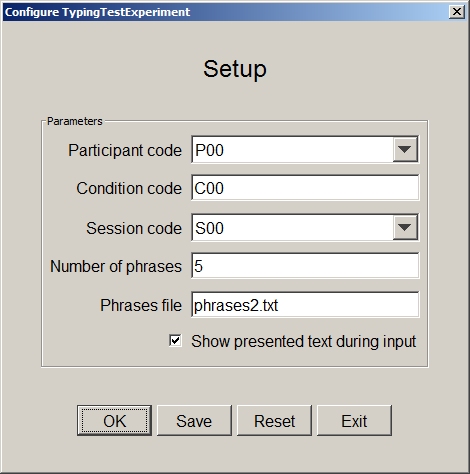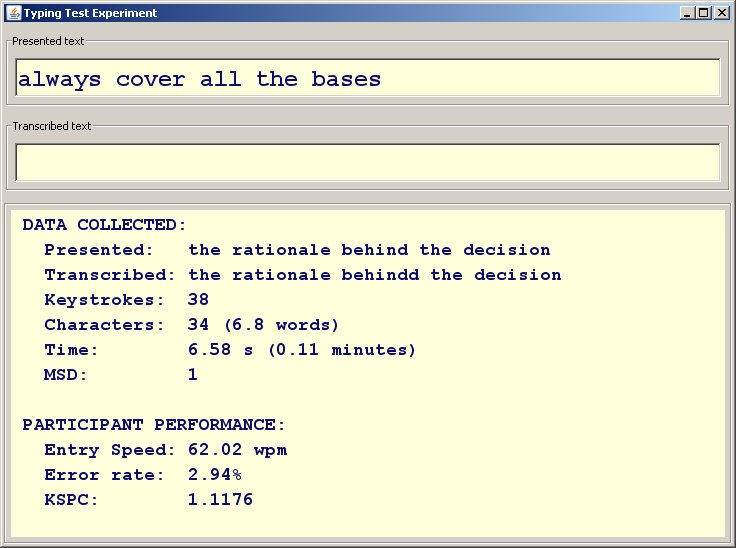 TypingTestExperiment
TypingTestExperiment
|
|||||||
| PREV CLASS NEXT CLASS | FRAMES NO FRAMES All Classes | ||||||
| SUMMARY: NESTED | FIELD | CONSTR | METHOD | DETAIL: FIELD | CONSTR | METHOD | ||||||
java.lang.ObjectTypingTestExperiment
public class TypingTestExperiment
Click here for instructions on launching/running the application.

The default parameter settings are read from a configuration file called
TypingTestExperiment.cfg. This file is created automatically when the application is
launched for the first time. The default parameter settings may be changed through the setup
dialog. The setup parameters are as follows:
Parameter Description Participant Code Identifies the current participant. This is used in forming the names for the output data files. Also, the sd2 output data file includes a column with the participant code.
Condition Code An arbitrary code used to associate a test condition with this invocation. This parameter might be useful if the software is used in an experiment, since conditions might be tested that are not inherently part of the application (e.g., Gender → male, female; Input method → mouse, stylus). The condition code is used in forming the name for the output data file. Also, the sd2 output data file contains a column with the condition code.
Session Code Identifies the session. This is useful if testing proceeds over multiple sessions to gauge the progression of learning. The session code is used in forming the name for the output data file. Also, the sd2 output data file contains a column with the condition code. Note: The setup dialog does not include an entry for "Block code". The block code is generated automatically by the software.
Number of Phrases Specifies the number of phrases presented to the participant in the current block.
Phrases File Specifies a file containing phrases of text to be presented to participants for entry. Phrases are drawn from the file at random. Typically, phrases2.txt is used. This is the phrase set published by MacKenzie and Soukoreff in 2003 (click here). Other file names may be specified. For example, the file quickbrownfox.txt contains the phrase
the quick brown fox jumps over the lazy dogThis file might be useful for demonstration or specialized testing.
Show Presented Text During Input A checkbox item that determines whether or not the presented text is visible during entry of a phrase. Either way, the text phrase appears at the beginning of a trial. If this option is unchecked, the phrase will disappear when the first keystroke is entered.
When the main program window opens, a phrase of text appears in the presented text field. As the user types, text appears in the transcribed text field. Timing begins with the first keystroke. At the end of each phrase, the user presses the ENTER key. This terminates entry of the current phrase, displays the summary statistics, and brings up the next phrase to be entered.
Here's a screen snap of the program in action...

Here are example output data files:
The data in the sd2 file are full-precision, comma-delimited. Importing into a spreadsheet application provides a convenient method to examine the data on a phrase-by-phrase basis. Below is an example of how the data might look after importing into Microsoft Excel: (click to enlarge)

Actual output files use "TypingTestExperiment" as the base filename. This is followed by the
participant code, the condition code, the session code, and the block code, for example,
TypingTestExperiment-P01-C01-S01-B01.sd2.
| Constructor Summary | |
|---|---|
TypingTestExperiment()
|
|
| Method Summary | |
|---|---|
static void |
main(java.lang.String[] args)
|
| Methods inherited from class java.lang.Object |
|---|
equals, getClass, hashCode, notify, notifyAll, toString, wait, wait, wait |
| Constructor Detail |
|---|
public TypingTestExperiment()
| Method Detail |
|---|
public static void main(java.lang.String[] args)
throws java.io.IOException
java.io.IOException
|
|||||||
| PREV CLASS NEXT CLASS | FRAMES NO FRAMES All Classes | ||||||
| SUMMARY: NESTED | FIELD | CONSTR | METHOD | DETAIL: FIELD | CONSTR | METHOD | ||||||